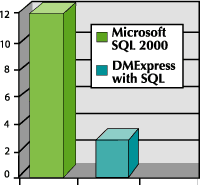CASE STUDY - GALOSI Speeds Its Business-Critical Application by Up to Four Times Faster
Commentary by Joaquin Lopez, CIO, GALOSI
GALOSI is one of the most innovative service providers in the recovery auditing services industry, performing comprehensive reviews of each client’s accounts payable and purchasing systems to uncover lost profits. CIO Joaquin Lopez explains, “We try to get every transaction that our clients make when they pay a particular invoice to their vendors. We then look for idiosyncrasies to determine if they overpaid their vendors. This can happen for a variety of reasons, including incorrect pricing or an allowance that wasn’t entered into the system. For one of our applications, we also look for duplicate payments by processing all of a client’s transactions in our system.”
In order to find duplicate payments, GALOSI was using Microsoft SQL 2000, but performance became an issue; the applications could take too long to complete. The company was also limited by the type of data that could be used. Lopez describes the issues: “I need to be able to process different formats. For example, sometimes the information will be in a flat file. With SQL I have to import the data first before I can use it, so it became a two-step process.”

Illustration 1. DMExpress minimizes the elapsed time of a recovery auditing application, running up to four times faster.
Due to these issues, Lopez began the search for a solution that minimized the elapsed time of the application while also providing the necessary data transformation and manipulation capabilities. Lopez decided to take advantage of Syncsort’s proof of concept offer in order to test the power and performance of DMExpress in the application. For the proof of concept, Syncsort’s technical support team developed a DMExpress solution to find the duplicate payments. “DMExpress completed the processing of the large files that I deal with in a very short amount of time. Compared to just using Microsoft SQL 2000, DMExpress is approximately three to four times faster,” Lopez said. The files vary in size from 50 to 100 GB, depending on the client. Once the data is processed down to only the information needed, the file size is reduced. For example, a 50 GB file can end up being 10 GB after processing. Lopez only examines one vendor at a time for a customer, so the data usually consists of less than 2 GB per session.
DMExpress completed the processing of thelarge files that I deal with in a very short amountof time. Compared to just using Microsoft SQL2000, DMExpress is approximately three to fourtimes faster.
—Joaquin Lopez, CIO, GALOSI
The application involves several steps that must be followed in order to determine whether or not there is a duplicate payment. For example, the first step is to search for the same invoice number with the same amount. GALOSI extracts nonnumerical data from the invoice number so that it consists only of whole volume numbers. This is because if a vendor submits invoice #1000 and it doesn’t get paid, the vendor will resubmit that invoice as #1000a. By deleting everything that’s nonnumerical from the invoice number, GALOSI is able to find these types of duplicate payments. Once the processing is complete, a team of auditors has to examine the data visually to accurately determine that a duplicate payment has been made.
Not only did GALOSI improve the performance of the application, but the company also gained the functionality it needed. “With DMExpress, I can work directly with a flat file to redefine the record layouts and start using the information. It also helps that DMExpress works with metadata. I receive information from a number of different files, but I like to provide our auditors with just one because it’s easier for them to examine the data. In order to do this, we’ll join the files using the metadata.” DMExpress also provides GALOSI with enhanced aggregation capabilities including minimum, maximum, count, and average. Using the DMExpress advanced data management (ADM) component in the application, Lopez was able to divide two numerical fields in a record to produce another field needed for analysis. The join feature was also used to associate duplicate payments, while summarization was used to filter by occurrence for certain payments.
This article originally appeared in the issue of .